I’ve been participating in the A&S 50 Challenge with the goal of reproducing 50 different period bead patterns. I’ve since met that goal and am now aiming for my second 50 patterns. My photography is lagging behind, but at last guess I’ve got 75+ different replicas of various period bead patterns. I run a small business selling these replicas, which pretty much pays for my glass to keep the hobby going. ![]()
 1 Black base bead with red, yellow, or white zigzag pattern and yellow ends Frankish, Anglo-Saxon – c400AD – 850AD (?) In white: Based on Frankish glass bead found at Dunadd, Argyll. National Museums Scotland. (Artifact #RLS 000-000-582-336-C) Also Metropolitan Museum, NY – Accession number 17.193.45 – Frankish, 6th century. In red: based on unknown early medieval bead from Portable Antiquities Scheme.
1 Black base bead with red, yellow, or white zigzag pattern and yellow ends Frankish, Anglo-Saxon – c400AD – 850AD (?) In white: Based on Frankish glass bead found at Dunadd, Argyll. National Museums Scotland. (Artifact #RLS 000-000-582-336-C) Also Metropolitan Museum, NY – Accession number 17.193.45 – Frankish, 6th century. In red: based on unknown early medieval bead from Portable Antiquities Scheme.
2 Green bead with blue and white dots Norse, Celtic; 9th century. Johan Callmer designates this type as O052. (Johan Callmer, “Scandinavian Beads, ca. AD 700 – 1100.”)
3 Red or brown beads with red/brown, white, and blue layered dots. Norse, c885-915AD. Johan Callmer designates this type as B310.
4 Blue beads with layered blue and white dots. Very common, entire range of SCA period. Common style for many cultures and eras.
5 Blue beads with twisted stringer. Celtic, Norse, Roman, Anglo-Saxon; circa 50 AD – 800 AD. Based on designs from Johan Callmer’s bead charts, also bead SF4884 (Portable Antiquities Scheme, UK), found in Suffolk, England.
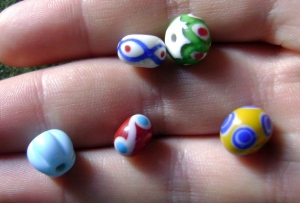 6 Lobed beads done in clear glass, colored glass, or faience. Very common, entire range of SCA period. Common style for many cultures and eras. Guido type 4iv (when in yellow); Guido type 6viii in blue. (Guido 1999: 39, 52-53)
6 Lobed beads done in clear glass, colored glass, or faience. Very common, entire range of SCA period. Common style for many cultures and eras. Guido type 4iv (when in yellow); Guido type 6viii in blue. (Guido 1999: 39, 52-53)
7 Reddish bead with a white wave pattern connected to blue and white dots. Norse, 790-820AD. Johan Callmer designates this type as B321.
8 Yellow bead with blue dots. Very common, 4th century BC – c1000AD. This pattern first shows up with the Phoenicians but also appears in many other cultures throughout early SCA period.
9a White bead with green double wave pattern and dots in the middles of where the lines intersect. Germanic, Continental Celtic, Anglo-Saxon, circa 6th – 7th centuries Style was popular in the Rhineland, northern France, and the Netherlands. Some are known to have come from a glassworks near Leiden around 600AD. Many were imported into England, where they have been found concentrated in the southern counties and as far north as Yorkshire. Margaret Guido calls this style type 3iiid. (Information from Margaret Guido, 1999:32-33.) Portable Antiquities Scheme artifact # LIN-D76CE0 (bead with green waves)
9b White bead with blue double wave pattern and dots in the middles of where the lines intersect. Germanic, Continental Celtic, Anglo-Saxon Circa 6th – 7th centuries. This style of bead (the white bead with colored lines) was popular in the Rhineland, northern France, and the Netherlands. Came from glassworks near Leiden around 600AD. Many were imported into England, concentrated in the southern counties and as far north as Yorkshire. Margaret Guido calls this style type 3iiic. (Information from Margaret Guido, 1999:32-33.) Portable Antiquities Scheme artifact NMS-B4D056 (bead with blue waves); also seen in Gotland necklace from Swedish Historical Museum, artifact #454255. SHM 4689; also a 6th century Frankish necklace at the Metropolitan Museum, NY, accession number 17.193.45.
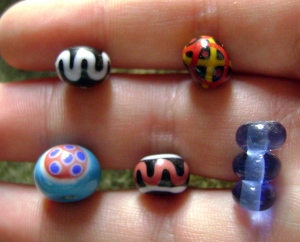 10 Blue/turquoise bead with large yellow/brown eye and blue dots. Roman, Romano-British, Romano-Germanic, Irish; 4th century BC – c7th century AD. Originally produced on the Continent in 4th C BC; imported to Britain via Roman occupation. Style was reintroduced by Irish glassworkers after 500AD. Also called Garrow Tor style. (Guido 1978: 62)
10 Blue/turquoise bead with large yellow/brown eye and blue dots. Roman, Romano-British, Romano-Germanic, Irish; 4th century BC – c7th century AD. Originally produced on the Continent in 4th C BC; imported to Britain via Roman occupation. Style was reintroduced by Irish glassworkers after 500AD. Also called Garrow Tor style. (Guido 1978: 62)
11 Beads in connected segments. Anglo-Saxon, Norse, Roman; 1AD – 1000AD. Segmented beads were extremely common and have been found in many Anglo-Saxon and Norse graves. Guido type 4v (when in yellow) and Guido 6vi (in blue); Callmer type E140 (in yellow) and E060 in blue. (Guido 1999: 38-39, 52)
12 Black bead with white wave pattern. Germanic, Roman, Norse, Anglo-Saxon; 1 AD – 850 AD. These ones are based off two beads found in Leicestershire (Artifacts # LEIC-F568D3 and LEIC-690732, Portable Antiquities Scheme, UK). This pattern was imported into England from German glass production sites. Several have been found at Roman sites in England. They were probably carried along as personal items by Germanic tribesmen serving in the Roman army. (Margaret Guido 1999:23) I have an article about this bead’s story.
13 Black bead with red bars and waves. Norse, c700 – 1000 AD. This bead pattern is based on those produced at Ribe, now in Denmark.
14 Black bead with yellow & red crossing waves. Anglo-Saxon, c450 – 530 AD Pattern is called Insular Overlying Waves by Birte Brugmann.
 15 Melon beads in blue or green with decorative lines. Norse, c800-1000 AD. Callmer type B536. An example can be seen at the Swedish Historical Museum (artifact 454727. SHM 10335.B) from Viking era Gotland.
15 Melon beads in blue or green with decorative lines. Norse, c800-1000 AD. Callmer type B536. An example can be seen at the Swedish Historical Museum (artifact 454727. SHM 10335.B) from Viking era Gotland.
16 Black bead with white and blue or red dots. Norse (but probably also plausible for much of Northern Europe), c600 – 1000 AD. Johan Callmer examined many variations on this pattern in his book on Scandinavian trade beads.
17 Red bead with black and yellow herringbone. Anglo-Saxon, 500AD – 1100AD. These represent Anglo-Saxon glassworkers’ attempt to copy the more technically complex versions of this pattern seen on the Continent. One was found at Sutton Hoo. Imitation Traffic Light (Brugmann), Guido type 8xviiib. I love these beads for their sneaky attempt at industrial espionage – check out my article about this bead’s story.
18 Blue bead with white dot and red in center. Anglo-Saxon, 410 – 800 AD. This is Guido’s type 6xiii, found in Cambridgeshire, Kent, Hampshire, Norfolk and Suffolk (Guido 1999, 273 and pl. 5). Also based on artifact # LIN-300AC3 (Portable Antiquities Scheme, UK).

19 Beads with spiral designs. Celtic, Eastern European; Iron Age through 700AD. Note: period colors for these are blue, green, yellow, and white. This kind of bead is found in North Scotland and in 5th-6th century Irish contexts, as well as Early Iron Age sites in Slovenia. (Guido 1978:85, Wood-Martin 1886:123; Peabody Museum – Artifact 40-77-40 13263)
 20 Swirly opaque blue and white barrel-shaped bead with red/yellow dots. Roman, Saxon; 500AD – 1100AD. Specific date of this piece is unknown, but it could have been produced at any time between the Iron Age and the Saxon period, with the Roman period or thereafter being more likely. Based on artifact # SUSS-B853D4 (Portable Antiquities Scheme, UK)
20 Swirly opaque blue and white barrel-shaped bead with red/yellow dots. Roman, Saxon; 500AD – 1100AD. Specific date of this piece is unknown, but it could have been produced at any time between the Iron Age and the Saxon period, with the Roman period or thereafter being more likely. Based on artifact # SUSS-B853D4 (Portable Antiquities Scheme, UK)
21 Black bead with red & white twist and red/white dots. Norse, c800-1000 AD. Based on a pattern in Johan Callmer’s work.
22 Black bead with yellow & red dragged trails. Anglo-Saxon, c500-1000 AD. Fairly common Anglo-Saxon pattern; also seen in many other cultures. The British Museum has one in its collections (accession number 1893,0601.218).
23 Black bead with red & white twist and murrini slices. Norse, c800-1000 AD. An example found at Södermanland is in the Historical Museum in Sweden. Accession number SHM 30621 (F55).
24 Red bead with yellow dragged trails. Very common, c500-1000 AD. Fairly common Anglo-Saxon pattern; also seen in many other cultures.
25 Brown bead with green & white stripe. British Isles, Scandinavia. An early medieval example found on the Isle of Wight (Portable Antiquities Scheme artifact # IOW1999-22). Same pattern with blue stripe is Callmer’s type F080, 845-860AD.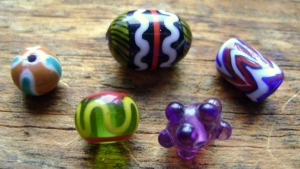
26 Purple clear beads with purple raised dots. Eastern Europe, Iron Age. Based on Early Iron Age examples from Sticna, Slovenia and currently at the Peabody Museum (Peabody Number 40-77-40 13506).
27 Black barrel bead with black and yellow twist, red center line, and white single wave. Norse, 790-820AD. An example found at Uppland is in the Historical Museum in Sweden. Accession number 16216.3.
28 Green clear with yellow wave and red bars. Roman, Norse Iron Age through 1000AD. An Iron Age example found in a Roman context in Skane is in the Historical Museum in Sweden. Accession number 113927. SHM 7667. Callmer type B531.
29 Blue bead with white and red dragged lines. Norse, c800-1000 AD. Callmer type B392. A Viking era example found at Gotland is in the Historical Museum in Sweden. Accession number 113874 SHM 2502.
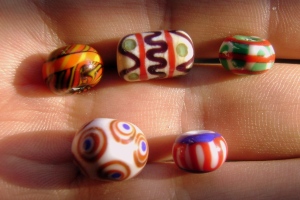 30 Green bead with white wave and red end lines. Norse, c860-885AD. Callmer’s type B545.
30 Green bead with white wave and red end lines. Norse, c860-885AD. Callmer’s type B545.
31. White barrel with black wave, red bars, black end zig-zag and green dots. Norse, c800-1000 AD. An example found at Södermanland is in the Historical Museum in Sweden. Accession number 10133 SHM 32298 (F4).
32 Herringbone or multiple twisty bead. Frankish, Anglo-Saxon, Norse; c500-1000 AD. Portable Antiquities Scheme NMS1951 (BEAD): “Early Anglo-Saxon reticella glass bead, cylindrical or drum-shaped with two and three layers of colourless translucent, opaque red (‘terracotta’) and opaque yellow glass arranged to form a herringbone pattern. In Guido’s (1999) book, Schedule, beads of this shape and decoration come under 8xviia; in Brugmann’s classification (2004) they are called ‘reticella.’ Brugmann dates them to her Group A2b, 530-580 AD.”
33 White bead with red wave and blue end lines. Norse, 860-885AD. Based on patterns analyzed by Johan Callmer in his book “Scandinavian Beads, ca. AD 700 – 1100.” Callmer’s type B020.
34 White bead with brown and blue stacked dots. Norse, c500-1000 AD. An example found at Uppland is in the Historical Museum in Sweden. Accession number 491070. SHM 33874 (F50).
 35 Blue & black bead with yellow curled pattern. Norse, c750-1100AD. The original probably used a slice of mosaic cane, but I replicated it with stringer work. A Viking-era example found at Gotland is in the Historical Museum in Sweden. Accession number 113874. SHM 2502.
35 Blue & black bead with yellow curled pattern. Norse, c750-1100AD. The original probably used a slice of mosaic cane, but I replicated it with stringer work. A Viking-era example found at Gotland is in the Historical Museum in Sweden. Accession number 113874. SHM 2502.
36 White bead with red/white/blue stacked dots, blue wave, and red ends. Norse, c800-1000 AD. An example found at Uppland is in the Historical Museum in Sweden. Accession number 491070. SHM 33874 (F50).
37 Black barrel spiralled with blue/white twist and yellow/red lines. Middle Eastern, first millennium BC. Unknown provenance.
38 Forget-me-not blue bead with white looped line. Norse, 790-820 AD. Callmer type B502.
39 Red squares with white/blue/yellow X’s. Norse, c750-1100AD. The original was probably a drilled slice of mosaic cane, but I replicated it with stringer work. A Viking-era example found at Gotland is in the Historical Museum in Sweden. Accession number 454352. SHM 16142.2
 40 Black bead with white waves and yellow dot. Anglo-Scandinavian, c700-1099AD. Polychrome glass bead from 16-22 Coppergate, York. Find # 10352
40 Black bead with white waves and yellow dot. Anglo-Scandinavian, c700-1099AD. Polychrome glass bead from 16-22 Coppergate, York. Find # 10352
41 Blue cylinder with blue/white eyes, yellow waves, twisted blue decoration. Irish, 400-600AD. Beads of this type have been excavated from Irish sites, particularly Lagore.
42 Black or blue translucent bead with white wave ends, pinched white-red lines, and yellow dot. Norse Iron Age. An Iron Age example found at Uppland is in the Historical Museum in Sweden. Accession number 108444. SHM 33346 A4, F6.
43 Sea-blue and white beads with 6-layer stacks of brown & white crowned with blue. Middle Eastern, c300BC. Based on finds from a 2400 year old grave found in the Altai Mountains. Beads were buried with a Siberian woman and may have come from Phoenicia.
44 Brick barrel with yellow/green twisty. Anglo-Saxon, 500AD – 1100AD. Digs at Eriswell and Lakenheath, UK. Birte Brugman includes this style under Imitation Traffic Light. Margaret Guido calls it type 8Xixa and notes finds were concentrated in East Anglia; Guido was unable to find any Continental equivalent.
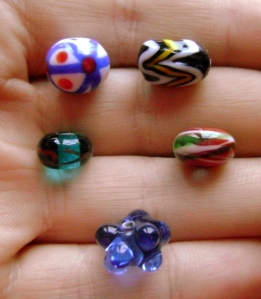 45 Clear blue beads with raised bumps. Rus, Viking. c800-1200AD. 12th century Russian finds from a Viking settlement along Black Sea. Provenance unknown – original was seen on a bead collector forum. The original bead may have been mold formed instead of done with stringer work, but this is hard to tell from the few photos available.
45 Clear blue beads with raised bumps. Rus, Viking. c800-1200AD. 12th century Russian finds from a Viking settlement along Black Sea. Provenance unknown – original was seen on a bead collector forum. The original bead may have been mold formed instead of done with stringer work, but this is hard to tell from the few photos available.
46 White bead with blue double wave, blue equator, and red dots. Anglo-Saxon, 500AD – 1100AD. Anglo-Saxon graves from Hadleigh Road Cemetery, excavated in early 1900s with unfortunately little attention paid to context.
47 Black barrel with white/yellow/white dragged equatorial lines. Islamic, circa 1200-1600 AD. From a commercial antiquities site.
48 Bottle-green clear bead with random red trails. Norse, c750-1100AD. From Viking era Rogaland, Norway. Artifact number Sf93960 S6329 at Museum of Archaeology, University of Stavanger, Norway.
49 Red bead with random white and clear-green trails. Finnish, Scandinavian; c500-1000 AD. From two examples from Pörnullbacken, Vörå, Finland.
…And, the big finish:
 Number 50! The most technically complex of the beads I did for the A&S 50 challenge, these are replicas of a Syrian bead at the Corning Museum of Glass (Artifact #98.1.62). The design dates between 700 and 1099AD. It features 12 slices of hand-pulled murrini cane, which I made myself with red and white stripes on a grey core. The murrini slices are then placed into a latticework of white stringer trails and each crossing point marked with a dot of yellow. They take forever to make.
Number 50! The most technically complex of the beads I did for the A&S 50 challenge, these are replicas of a Syrian bead at the Corning Museum of Glass (Artifact #98.1.62). The design dates between 700 and 1099AD. It features 12 slices of hand-pulled murrini cane, which I made myself with red and white stripes on a grey core. The murrini slices are then placed into a latticework of white stringer trails and each crossing point marked with a dot of yellow. They take forever to make.
So, that concludes my A&S 50 Challenge. I make all of these patterns for sale to historical reenactors who want to make sure even their little details are accurate, so if you’d like to acquire any of these please visit my Etsy store. Thanks for reading this all the way through!


How does one acquire your patterns?
I’m not entirely sure what you’re asking, so I’ll throw out a bunch of answers and hope at least one of them lines up. 🙂 If you’re looking to purchase replicas of these beads, I sell on Etsy at Heart of Oak Crafts. I too am an Easterner, and I sell my beads at events around New England and am delighted to do in person transactions as well. I will be at the Market Day at Birka in Stonemarche on Jan 24-25. If you’re asking about the knowledge to make these beads, I also travel with my torches and teach lampworking classes. For custom orders or if there’s something specific that catches your eye, email me (strangewayes@gmail.com) and we can talk further. I hope that helps?
Wonderfully beautiful work my friend!
I love that you included the time/place/digs for each of your items!! Did you work from tutorials, or did you trial-and-error your own skill set?
I worked entirely from my own skill set on these. I don’t think there are tutorials available for any of the patterns I replicated. All my bead designs are trial and error until perfected, since I’ve never taken a formal lesson ever since the very first day when a friend of mine showed me how to turn her torch on and make basic beads. Fortunately, I’ve never set myself on fire yet! 😉
First congratulations on your Laurel!!
Second, I have a question. Beads 26 and 45 look very similar from a construction perspective (I.E. transparent bead with stringer made dots). Since Slovenia and the area around the Black Sea are basically the same region, is the main difference the timeframe? 1300 – 700 BC vs 800 to 1200 AD? I hadn’t realized there two separate extant beads. The fact there are two clears up some confusion on my part since I had seen what I thought was the same bead in two separate sources tagged with two very different dates. In looking at the two, I can’t tell if there are more dots on one vs the other. Both yours and the sources I have looked at seem to have two rows of dots on both. Although I do have a picture of a purple translucent with three rows but I need to go back and look to make sure that’s an accurate reproduction of some extant source.
I have loved watching this list unfold. It has truly been educational for me. You have provided quite a bit of inspiration and pushed me towards stretching my comfort zone in my efforts to replicate some of these beads. Thank you!
Hello, and thanks! The blue dotted one comes from one picture on a bead collectors’ forum. It’s probably the shakiest-documented one on my list, sadly. I usually make them with a 1-2-1 pattern of dots all around, but I think the original was three rows, staggered, and probably mold formed. I’ve also seen examples of raised opaque blue dot beads at the Peabody Museum (same place where the purple ones are).
Hey there! I have noticed beads 51 through 57b and 61 through 63 on your Etsy page. Are you planning to put those up here as well? Oh and I have been living suspense over what patterns 58 through 60 are. 🙂
Haha, I will. It’s a question of time and remembering to do so. 🙂